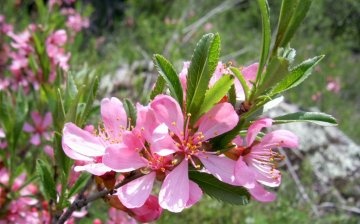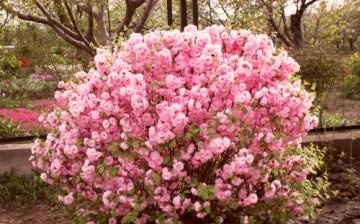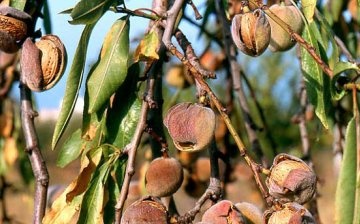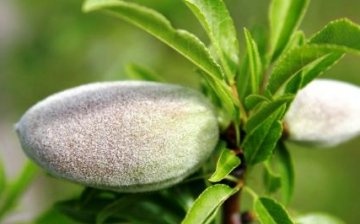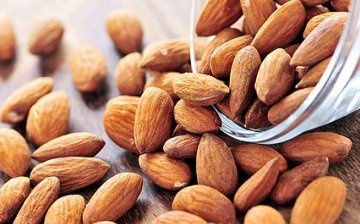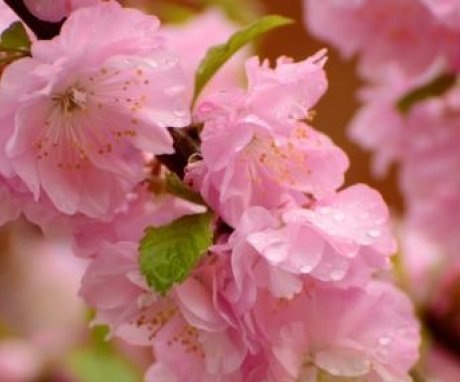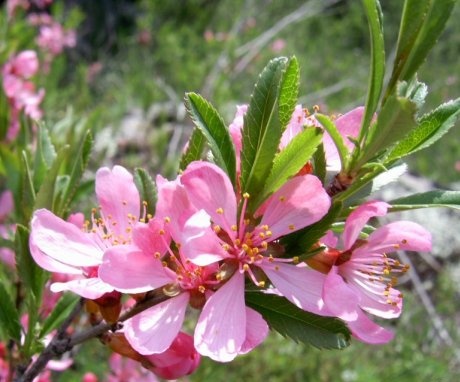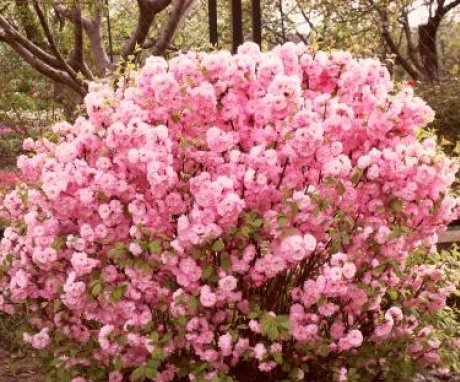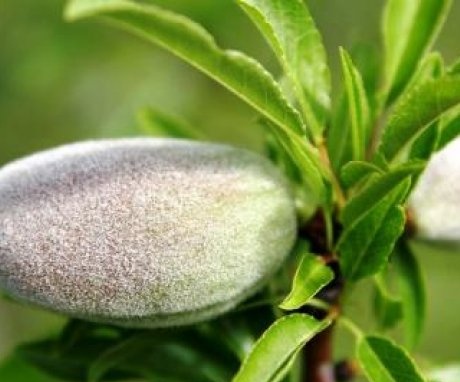Characteristics and secrets of agricultural technology of steppe almonds
Almond Is a southern, thermophilic plant. Caring for it is due to the place of its growth in nature. This is a rather beautiful plant, so recently summer residents and gardeners from various regions, including cold ones, have been planting it at home. Observing several rules, almonds will annually delight their owners with flowering and fruits.
Content:
- General information about almonds
- Almond varieties
- Steppe almond care
- Breeding secrets
- Diseases and pests
- Application of almonds
General information about almonds
Almond Is a perennial plant that belongs to the Rosaceae family. It grows in the form of a shrub or tree, the height of which can reach 3-10 meters. The stems are long, there are highly branching varieties. Their bark is colored gray, reddish or brown.
It blooms with small flowers, the color of which is pink, white or crimson.
Leaves are medium in size, mostly oblong-oval with a pointed end. Their color depends on the variety. The plant tolerates heat and dry periods well, varieties have also been bred that can withstand frosts down to -25 degrees.
The root system consists of several large and strong roots that are weakly branched. Thanks to these roots, which go deep into the ground and feed the plant, almonds are drought-resistant. Fruiting almond trees or bushes give harvest in mid-September. The fruit is a drupe, the length of which can be up to 6 cm. Inside it there is a grain without a pronounced aroma and with a pleasant sweetish taste.
Almond varieties
Popular varieties of almonds:
- Steppe almond Is a perennial plant. It grows in the form of a bush, the erect branches of which grow 1.5 meters in height. Leaves, small in size, oval-oblong, lacent, painted in a dark green tone. The flowers are small, the petals are pink. The buds bloom in early spring along with the leaves, flowering lasts 7-10 days. Steppe almonds are also called legumes. Thanks to its numerous branches, the bush forms a ball shape. It tolerates frost well. Recommended for planting in well-lit areas.
- Georgian almonds. It is a bush, the height of which reaches 100 cm. Its leaves are long, large, up to about 9 cm in length, not densely located on the stems. The flowers are large, the petals are painted in a bright pink tone. Abundant flowering begins in late spring. The fruits are shaggy, their full ripening occurs in September. Young bushes do not give harvest, fruits are borne only by adult bushes, which are more than 6 years old. Bush tolerates frost well if the branches have time to ripen.
- Common almonds. This species can grow as a small tree or bush. Its branches have a reddish tint. The height of the plant is in the range of 3-8 meters, depending on the place of growth and the type of plant. After the bush fades, its leaves stretch out and become oval-oblong. The flowers are medium in size, the calyx is pink and the corolla is red.
- Petunnikov's almonds.This species is a shrub 100 cm high. In nature it grows on rocky slopes, forming dense thickets. Its branches are erect, sticking out in different directions. Each has a large number of small, shortened shoots. The bark on the branches is colored grayish-brown. Leaves are medium in size, elongated, with a pointed end and jagged edges. It blooms with beautiful pink double flowers. It tolerates drought and winter frosts well.
- Three-lobed almond is a perennial plant whose branches extend 3 meters in height. It is a bush with a large and spreading crown. The bark of the branches is colored gray. The small leaves have three lobes, which is why the species got its name. When blooming, there is pubescence on the underside of the leaf, which disappears over time. They grow on branches in bunches of several pieces. The flowers are small and grow in pairs on the branches. The petals are colored pink, crimson or dark pink. Flowering begins in late spring and lasts 15-20 days. Leaves bloom after flowering ends.
Steppe almond care
Almond bushes and trees are planted in sunny, well-lit areas. In partial shade, they will also develop well and bear fruit. An important criterion for the place for a plant to grow is its protection from winds and drafts, which adversely affect almonds.
Almost any soil will do. But preferably before disembarking seedlings fertilize the soil with organic matter. Light, loose, fertile soils with good drainage are best. Stagnant water or close-lying groundwater negatively affects the plant, and can lead to its death.
Watering almonds:
- Almonds are not picky about watering. But during the flowering period, the plant uses a large amount of moisture, this is especially true for ornamental varieties. If watering is scarce, the flowers will begin to fall off quickly before reaching their normal size.
- If the plant is planted in sandy soil, watering is carried out frequently. At the same time, it is necessary to control the drying out of the land near the bush.
- When the soil is waterlogged, the root collar of almonds can rot, thereby destroying the plant.
- After watering, it is recommended to regularly loosen the soil, giving the roots fresh air and removing weeds.
Almond feeding:
- Almond plantations need to be fed annually. To do this, in the spring, organic matter is introduced under the bush and mineral fertilizers.
- As organic feeding a strong solution can be used mullein.
- In the middle of summer, the plant is fed with a good dose of superphosphate, about 30 grams per 1 bush, which stimulates wood ripening, abundant flowering and harvest.
- In the autumn period it is also necessary feeding, as preparation for winter. Superphosphate and potassium-containing fertilizers are used.
Almonds tolerate constant cold well. But a change in temperature in the winter season can have a bad effect on the plant. The reason for this is that almonds are in a state of sleep for a month and any premature warming wakes them up. The juice flows actively through the branches, the buds swell, and subsequent frosts kill everything.
To plant or transplant an almond seedling must be prepared for it. For this:
- Dig a recess with such dimensions that the roots fit easily and freely settle in it.
- At the bottom of the pit, drainage is laid out with a thick layer of up to 20 cm.It can be crushed stone, broken brick or expanded clay.
- Coarse sand is poured over the drainage.
- The excavated soil is mixed with manure, dolomite flour, humus, sand and leafy soil.
- The plant is planted so that the root collar is slightly higher than the soil.
Almond trees and bushes are pruned annually in the spring.This promotes the formation of new shoots, strengthens the root system of the plant and makes the crown lush, dense and neat.
During pruning, dry and diseased branches are removed.
The trees cut the center crownsremoving all shoots growing inward. At the bush, a simple haircut is used to form the required appearance. So that the young shoots ripen well for winter, and the future buds in the buds do not freeze, in August the edges of such branches break off. This stops the growth in length and helps to strengthen the shoot. At the end of autumn, before frost, almonds must be prepared for wintering.
Breeding secrets
Reproduction almonds can be carried out using seed, by root shoots, cuttings or vaccinations.
Reproduction by seeds:
- With the help of seeds, only those varieties that bear fruit can be propagated. These are mainly plants growing in warm regions.
- The collected bones are left for planting in the spring.
- If this process is carried out in the fall, then local rodents will destroy most of the seed.
- Having selected a bright area, and having dug up and fertilized the soil, the grains are planted in the ground.
- To do this, you need to wait for constant warm weather and well-warmed earth. Good seedlings grow from them quickly up to 30 cm in height.
If a tree or bush does not bear fruit, then it can be propagated using cuttingsthat are cut in the month of June. Each should have multiple nodes. They can be rooted indoors or planted in the ground, having previously stood in a stimulating solution. It is buried in the soil, leaving 1-2 nodes on the surface. For the winter, cuttings are covered.
Root shoots or layering can also propagate those types of almonds that do not produce fruit.
To do this, the shoot is carefully dug out together with a part of the root and transferred to a previously prepared and fertilized hole. Well-ripened branches are cut for grafting. Almonds can be grafted onto peaches or plums. The process is quite lengthy and painstaking and requires skill.
Diseases and pests
In the period from spring to autumn, almonds can be attacked by various pests... If aphids have appeared on the branches and foliage, then the plant can be treated with a strong soapy solution several times at intervals of 1-2 days. If it reappears, repeat the procedure. Also, an infusion of tobacco or potato tops may be suitable for this.
Every spring, the trunk of the plant must be whitewashed with a lime solution to protect the tree or bush from bark beetles.
Before budding, the branches are sprayed with nitrafen to prevent the appearance of the leaf roll. Also in the spring, the plant is treated with special preparations for fungal diseases.
Application of almonds
The almond blossom has attracted the attention of landscape designers. Increasingly, this plant is used in decorating home gardens and plots. It can be combined with other plants and with each other, creating a unique spring ensemble. With an annual pruning and the formation of a tree or almond bush, the plant will have decorative effect throughout the season, and not only during the budding period.
In warm regions, almonds can be harvested fruit.
These are bones, in the middle of which there is an edible kernel. It contains vegetable protein, fats, nutrients, vitamins and minerals. Almonds are recommended for asthma, anemia, diabetes and headaches. It calms the nervous system and has a beneficial effect on the entire body.
Almond oil is used in cosmetology. Creams containing this ingredient soften and smooth the skin. Almond oil shampoos strengthen hair and stimulate hair growth.
More information can be found in the video.





